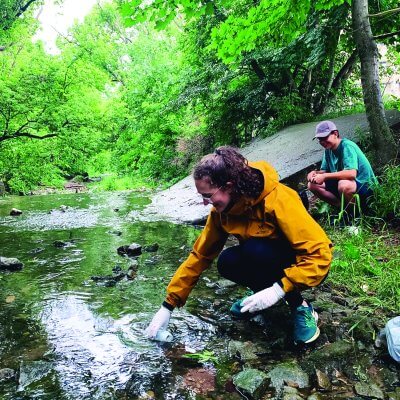What do dog feces and COVID-19 have in common? You may assume that it isn’t much, but this summer, both Claire Semelhago and Carys Vyn conducted research using polymerase chain reaction (PCR) testing – a type of molecular testing that can look for the presence of DNA in all kinds of different samples – like dog feces and nose swabs.
PCR is a technology that replicates a DNA template into millions of copies in a process called amplification. Real-time testing can track that amplification while it takes place by using fluorescent molecules to track the amount of DNA that has been amplified. The test confirms the presence and quantity of particular sequences within a sample, and it can be done quickly and inexpensively by analyzing up to 96 samples at a time.

PCR has become the gold standard of the pandemic. It is what allows lab technicians to determine if asymptomatic people have COVID-19 through the testing of nose swabs. However, it can also be used by researchers to better understand the properties of nucleic acid. This summer, Semelhago, working under assistant professor of health sciences Dr. Gloria Kim, was able to use PCR technology to investigate the denaturation and renaturation of DNA, and specifically how complementary and mismatched sequences behave. Understanding these kinetic properties of DNA is useful in detecting errors or mismatches in various sequences. By using PCR to test a large number of DNA sequences in vitro, advancements can be made in biochemistry, and researchers can potentially move forward in finding ways of targeting mismatches in the DNA; one application of this is using pharmaceutical drugs. Mismatches can cause medical conditions such as cancer, so being able to understand how pharmaceuticals can interact with DNA to prevent further harm is beneficial for the development of new cancer therapies.
This research aligns well with Redeemer’s mission. According to Semelhago, “As a Christian researcher, I feel called to use my gifts to make advancements in science that will benefit the health and wellbeing of others, and knowing that my work could eventually be used by others to advance medical treatment is very fulfilling to me. God also takes delight in us discovering parts of his beautiful and intricate creation, and I feel especially close to him when investigating his handiwork in DNA.”
As a Christian researcher, I feel called to use my gifts to make advancements in science that will benefit the health and wellbeing of others.
One sample that responds well to this kind of testing is water. Carys Vyn, working on the Chedoke Watershed Project under professor of chemistry and environmental science Dr. Edward Berkelaar, continued the work of the last number of years analyzing contamination in the watershed. The project has made use of PCR testing to identify different types of Bacteroidales, fecal bacteria that live in the guts of animals and have a unique genetic code. Vyn, working with Redeemer students Owen Vander Meulen and Joshua Sloots, was able to identify the levels of human, canine and “other” Bacteroidales in the watershed in multiple locations of the Chedoke and Red Hill watersheds. The results have continued to be sobering over multiple years of Redeemer’s involvement: in the Chedoke watershed, Mountview and Westcliffe Falls both had the highest levels of human Bacteroidales, although all locations in both watersheds have bacterial levels that exceed the human health risk threshold.
Vyn explained why this research is important to her, and to Redeemer. “I have always been a huge advocate for animal and environmental care. This research allowed me to directly contribute to learning more about the Hamilton watersheds which have significant impacts on the surrounding ecosystems. By providing this important data to the City of Hamilton, I can make improvements to the sewage infrastructure, and subsequently improve the health and wellbeing of the plants and animals that depend on the watershed to survive.”
Semelhago and Vyn were two of the five students to receive Undergraduate Student Research Awards this summer, supported by NSERC and Redeemer. The other students were Alexa White and Cloe Mitchell, who worked with Dr. Darren Brouwer studying co-crystals and polymorphs, and Carraugh Brouwer, who worked with Dr. Kevin Vander Meulen and Dr. Mike Cavers examining the eigenvalues in sign matrices. All of the summer students appreciated the opportunity to participate in meaningful research that furthers their understanding of their discipline.